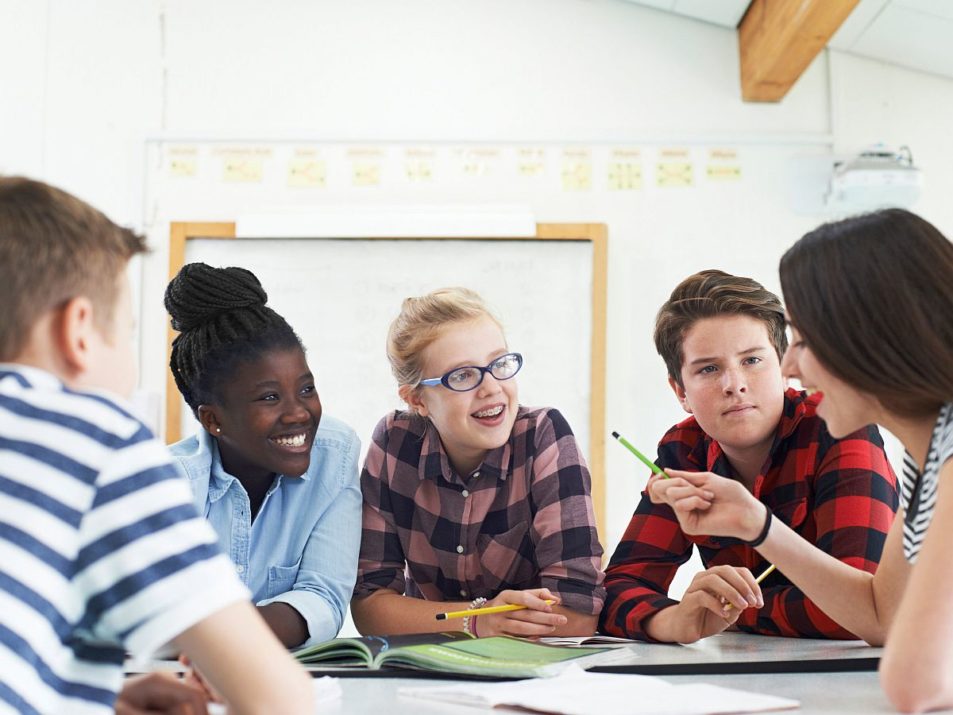In the education field, the traditional model of solitary learning is gradually giving way to a more collaborative approach. Group work has emerged as a powerful tool in teaching, fostering an environment where students actively engage with their peers to achieve common goals. In this article, VTJ will discuss the significance of group work in education, highlighting its numerous benefits and providing real-life examples of its successful implementation.
What Is Group Work?

What Is Group Work? Group work involves students working together in small groups
Group work refers to a teaching method that involves students working together in small groups to accomplish a shared task or achieve a common goal. It is a collaborative approach that encourages active participation, engagement, and interaction among students. In group work, students collaborate, communicate, and learn from each other, fostering a cooperative learning environment that goes beyond individual efforts.
Read more: 15+ Ways to build confidence in your ESL students
Examples Of Ways To Structure Group Work

Examples Of Ways To Structure Group Work
Formal Cooperative Learning Groups
Formal cooperative learning groups are structured groups where students work together for an extended period of time on a specific project or assignment. These groups are carefully designed to ensure equal participation and accountability among members. Each group member is assigned a specific role or task, and they collaborate to complete the project. This approach promotes teamwork, division of tasks, and the development of interpersonal skills.
Read more: 14 Types of teaching methods for an effective lesson
Think-Pair-Share is a simple yet effective group work strategy that encourages active participation and collaboration among students. This approach involves three stages: thinking individually, pairing up with a partner, and sharing thoughts with the whole class. Think-Pair-Share provides students with the opportunity to reflect on a question or problem, discuss their ideas with a peer, and then contribute to a larger group discussion.
- During the first stage, students are given a question or problem to think about individually. This allows them to process the information, analyze it, and formulate their own thoughts and ideas. This step promotes independent thinking and encourages students to engage with the topic on a personal level.
- In the second stage, students pair up with a partner to discuss their thoughts and ideas. This collaborative discussion allows students to share their perspectives, exchange insights, and challenge each other’s thinking. Through this interaction, students gain new perspectives, refine their understanding, and develop their communication skills.
- Finally, in the sharing stage, pairs of students present their ideas to the whole class. This step encourages active participation and provides an opportunity for students to contribute to a larger group discussion. It allows for the exploration of different viewpoints, the identification of common themes, and the clarification of any misconceptions.
Read more: How To Write a Curriculum in 8 Steps: A Complete Guide
Peer Instruction
Peer Instruction is a highly effective teaching method, especially in large class settings, that encourages active learning and student engagement. This approach revolves around conceptually based multiple-choice questions that prompt students to think individually and vote on their answers. After voting, students engage in discussions with their peers, allowing them to exchange ideas and perspectives. This collaborative process often leads to a deeper understanding of the topic.
During the discussion phase, students have the opportunity to reconsider their initial answers based on the insights gained from their peers. This dynamic interaction fosters critical thinking and encourages students to challenge their own assumptions. The instructor then reveals a graph displaying the distribution of student responses, which serves as a catalyst for a whole-class discussion. This graph stimulates further exploration of the topic, as students analyze the different perspectives and reasoning behind the various answers.
Read more: 4 Types of Learning Styles: How to Use VARK Model in Teaching
Jigsaw
This approach involves breaking down a complex task or topic into smaller parts, assigning each group member a specific piece of the puzzle. Each student becomes an expert on their assigned part and then collaborates with members from other groups who have studied different parts.
In the Jigsaw method, students work together to understand their assigned content thoroughly. They become responsible for mastering their specific area and acquiring in-depth knowledge. Once they have become experts, students regroup with peers who have studied different parts. In these new groups, each student takes turns teaching their area of expertise to the others. This process encourages active teaching and learning, as students rely on each other’s knowledge to complete the puzzle.
Read more: How To Write a Lesson Plan in 6 Steps: The Complete Guide
The Importance Of Group Work in Teaching

The importance of group work in teaching: Group work is an essential component of effective teaching and learning
Group work is an essential component of effective teaching and learning. It offers numerous benefits that contribute to students’ academic, social, and personal development. Group work promotes active learning by engaging students in discussions, problem-solving, and critical thinking. It allows students to explore different perspectives, share knowledge, and learn from their peers. Through collaboration, students can deepen their understanding of the subject matter and develop higher-order thinking skills. Working in groups can increase student engagement and motivation. Additionally, It creates a supportive and inclusive learning environment where students feel valued and connected. Group work encourages active participation and fosters a sense of ownership over the learning process, leading to improved academic performance.
Read more: 20+ Effective Classroom Management Strategies and Techniques
Advantages And Disadvantages Of Group Work
Advantages:
- Increased Learning Opportunities: Group work provides students with diverse perspectives and knowledge, expanding their learning opportunities beyond what they might achieve individually.
- Skill Development: Group work helps students develop important skills such as communication, teamwork, problem-solving, and leadership, which are valuable in various aspects of life.
- Enhanced Critical Thinking: Collaborative discussions and interactions in groups stimulate critical thinking and encourage students to analyze, evaluate, and synthesize information.
- Peer Support and Motivation: Working in groups fosters a supportive environment where students can help and motivate each other, leading to increased engagement and academic performance.
Read more: How to Teach Writing Skills to Students Effectively in 8 Simple Steps
Disadvantages:
- Unequal Participation: In some groups, certain individuals may dominate the discussion, while others may contribute less. This can lead to unequal participation and limited learning opportunities for some students.
- Conflict and Disagreements: Group work can sometimes lead to conflicts and disagreements among group members, which may hinder the learning process and create a negative atmosphere.
- Time Management Challenges: Coordinating schedules and managing time effectively can be challenging in group work, especially when students have different commitments and availability.
Read more: 10+ Strategies of How to Teach Reading Comprehension in the Class
Strategies to Implement Group Work Effectively

Strategies to implement group work: Prepare for group work, develop students’ group work skills, help students reflect on their group work
Preparing for Group Work
Preparing for group work is crucial to ensure its effectiveness. By establishing clear goals and expectations, students will have a clear understanding of what is expected of them and what they need to achieve as a group. Clearly communicate the purpose and objectives of the group work, and set specific goals and expectations for each group member’s roles and responsibilities. Additionally, creating diverse and balanced groups can enhance collaboration and learning. Consider students’ strengths, skills, and personalities when forming groups, aiming for a mix of abilities and backgrounds. Lastly, provide necessary resources such as materials, technology, or relevant information to support students in completing their group work effectively.
Read more: 5 Types of Teaching Styles (Their Pros & Cons)
Developing Students’ Group Work Skills
Promoting individual accountability is crucial to ensure that each group member actively contributes and takes responsibility for their assigned tasks. Encourage equal participation by fostering an inclusive environment where all students feel comfortable sharing their ideas and opinions. Additionally, focus on developing problem-solving skills by presenting challenging tasks or scenarios that require critical thinking, analysis, and evaluation of different perspectives.
Read more: Why Students Get Bored & How to Engage Bored Students in the Class
Facilitating and Monitoring Group Work
As an educator, facilitating and monitoring group work is essential to ensure its smooth progress. Provide guidance and support to groups by being available to answer questions, clarify instructions, and offer feedback on their progress. Act as a facilitator, encouraging students to seek assistance when needed. Monitor group dynamics to ensure that all members are actively engaged and that conflicts are resolved constructively. Observe group interactions and intervene if necessary to address any issues that may arise.
Read more: 21+ Best Classroom Management Books for Teachers
Helping Students Reflect on Their Group Work
Encourage students to reflect on their experiences by asking them to evaluate their group’s performance and their own contributions. Provide prompts or questions that encourage critical thinking about the strengths and weaknesses of their group work. This reflection can help students identify areas for improvement and develop self-awareness of their collaborative skills. Additionally, encourage students to share their reflections with their group members, fostering open and honest discussions about their collective experience.
Read more: 6 Types of Assessment in Education & How to Use Them
Group work plays a vital role in teaching and offers numerous benefits for students. By engaging in collaborative activities, students develop essential skills that are valuable in both academic and real-world settings. Hopefully, this article can help you fully understand the benefits of group work and apply it in your classroom.
FAQs
What are the tips for successful group work participation?
Tips for successful group work participation include actively engaging in discussions and tasks, communicating effectively with group members, sharing ideas, and taking on assigned tasks with enthusiasm.
What are the four types of group work?
Four types of group work include formal group work, cooperative learning, problem-based learning (often known by its acronym, PBL), and informal group work.
Read more: What is blended learning? Types, Examples & Benefits?
Are you facing difficulties in finding and securing teaching positions in Vietnam? Are visa procedures causing you trouble? Feeling overwhelmed and directionless upon your arrival in Vietnam for teaching assignments? Don’t worry, VTJ’s English Teaching Placement in Vietnam (EPIV) Program 2024 provides comprehensive support to solve ALL the matters.
👉👉👉 Click HERE to request free consultation




